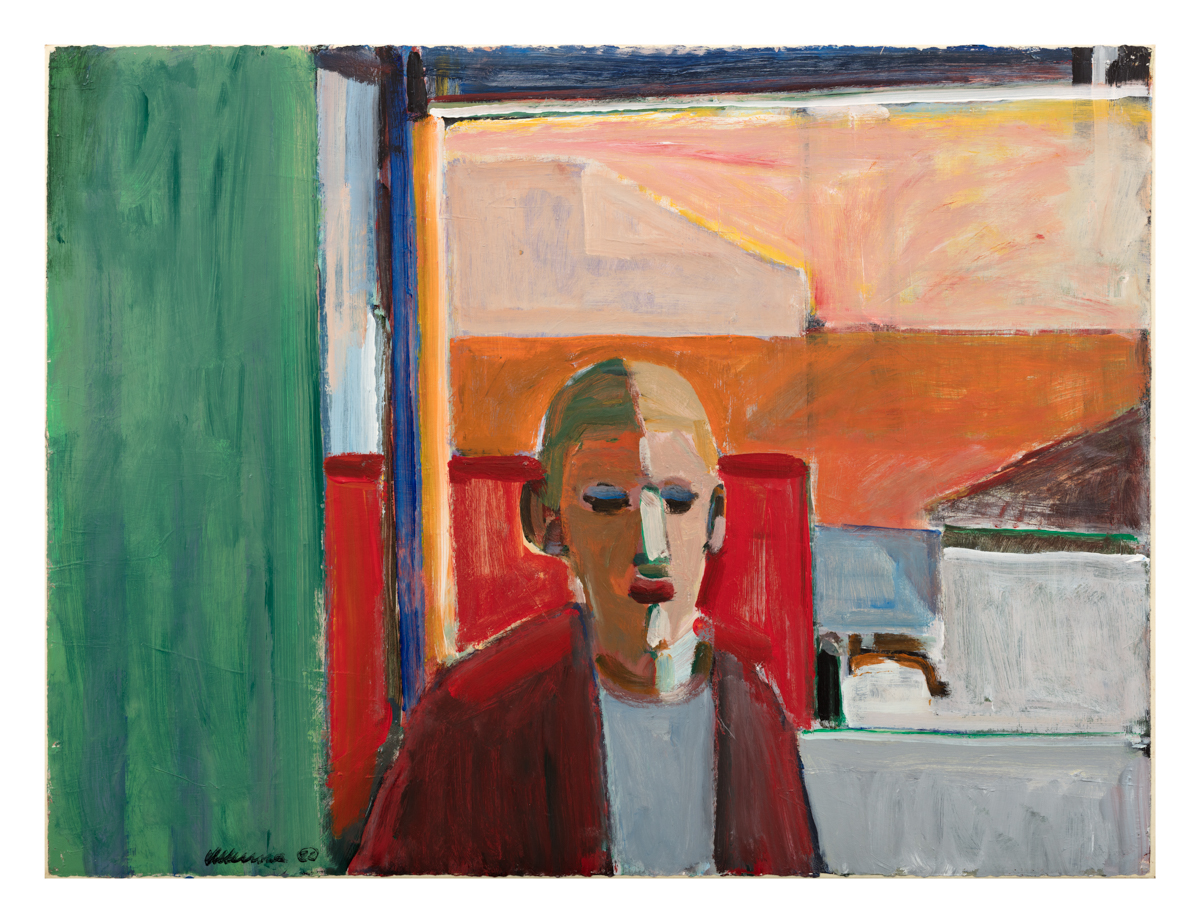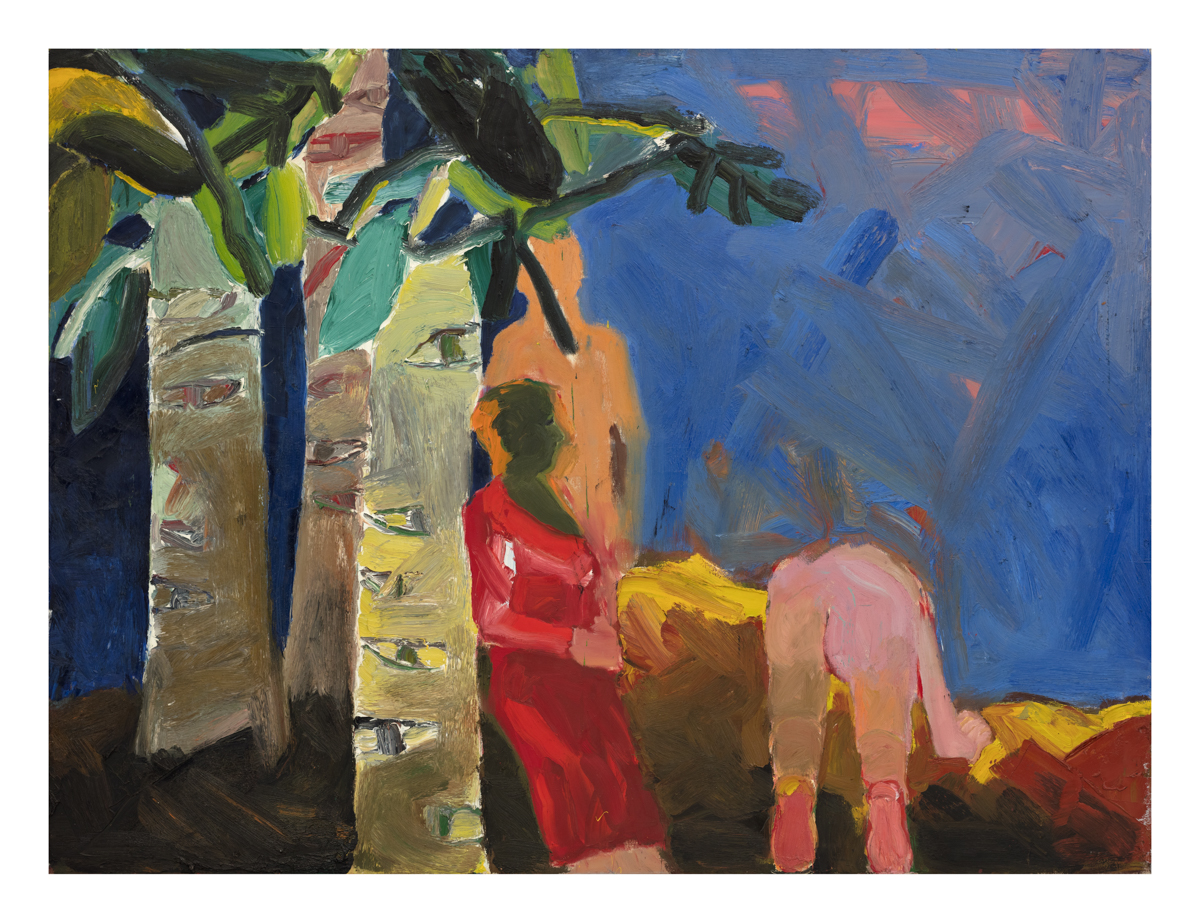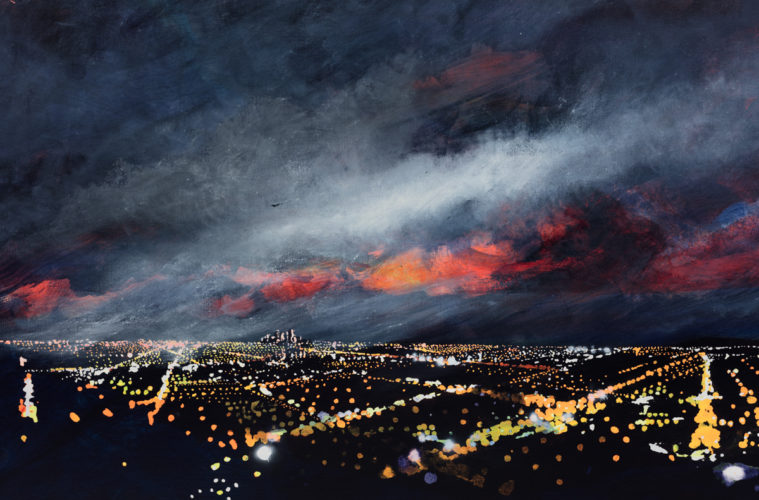Featured Image Above: Peter Alexander, “Thrasher,” 1992. Oil on canvas, 48 x 84 in. ©2018, Peter Alexander. The Buck Collection at the UCI Institute and Museum for California Art.
Stephen Barker’s visual art tours are almost legendary. The dean of the UC Irvine Claire Trevor School of the Arts and executive director of its Institute and Museum for California Art (IMCA) seems to weave a spell when talking about the artworks in the Gerald Buck Art Collection. Moving through UCI’s University Art Galleries with a dancer’s grace and speaking with an actor’s gravitas, Barker peppered his remarks with humor as he discussed Buck Collection pieces by Peter Alexander, Richard Diebenkorn, Ed Kienholz and many others. The charismatic educator was describing the history, significance and aesthetic theories of the various displayed works, in styles from abstract and figurative to assemblage and light and space.
The 3,310-piece Buck Collection sprung into being in 2014, and it’s considered by many art aficionados the finest private collection of 20th century California art ever assembled. “In my first week as interim dean, James Irvine Swinden, Irvine Museum’s president, told me of the donations of the museum’s collection of 19th and 20th century paintings, sculptures and works on paper,” recounted Barker to the Weekly. “That same week, lawyers handling the estate of Gerald Buck informed me that UCI had received the Buck Collection. UCI Chancellor Howard Gillman asked me to suggest what we should do with 4,657 works of California art. Voilà, the Institute and Museum for California Art.”
Barker expanded his UCI role to include responsibilities as IMCA’s executive director. His new responsibilities included fundraising, learning about the two collections and its artists and art pieces, and curating exhibitions. When this institution combining the two collections opens in five years, UCI will have “the best collection of California art to be seen anywhere,” proclaims Barker.
In 2017, he curated an exhibition of 80 of the Buck’s works at a private 3,000-square-foot art gallery in Laguna Beach. To the dismay of many art lovers, this show was open only to the press and selected others.

Henry Villierme, “Coming In,” 1992. Acrylic on Arches paper. 23 x 30 1/2 in. ©8/06/2018, HENRY VILLIERME. The Buck Collection at the UCI Institute and Museum for California Art.
Last fall, he co-curated (with Kevin Appel, UCI professor and chair, Department of Art, and Cécile Whiting, UCI chair, Department of Art History) a show of 49 of the Buck’s art pieces for the University Art Galleries. The “First Glimpse” exhibition ran from last fall to January 5, attracting 8,500 visitors. Among the other artists represented were Larry Bell, Joan Brown, Tony DeLap, Lorser Feitelson, Roger Kuntz, Gilbert Luhan, Helen Lundeberg, David Park, Agnes Pelton, Wayne Thiebaud and Peter Voulkos.
Elucidating the collection, Barker wrote in the exhibition’s catalog, “The artwork persists in arousing in us the fundamental questions of relevance, power and meaning — questions that are not in the artwork but in us.”
On the day that “First Glimpse” closed, hundreds of people showed up to view the works, while several docents guided the visitors. Barker, who joined the throngs in attendance, was eager to talk about the artworks on display. He was clearly a man with deep insights about and passion for the artists and their artwork. Yet as he explains, he has no formal training in the visual arts and taught himself — through reading, looking and listening — about the artists, their lives and techniques, and about the natures and intentions of their modern and contemporary art pieces.
“I’m an autodidact and a sponge for information,” Barker told us. He added that, as a “ridiculous Francophile,” he taught himself French and has translated writings from French to English, chuckling, “I get away with murder.”
In spite of Barker’s modesty, he has a profoundly accomplished résumé.
“I was born in a small town in southeast Iowa on the Mississippi River. My mother’s family had a venerable history of civic, business and academic activity, while my father taught his father to write his name in order to sign Navy discharge papers. My younger brother is a naturalist/watercolorist of amazing talent. My younger sister makes beautiful jewelry. I started acting in community theater in middle school and continued into high school.”
“On a lark,” Barker applied to Amherst College — his sole application — and was, as the dean put it, “miraculously” accepted. It was an opportunity that blossomed into a globe-spanning artistic education. “I acted and directed and even started my own theater there. I also had my first interactions with great art of all kinds, from seeing James Brown at the Apollo Theater to attending the Yale Repertory Theater,” said Barker. “I also started painting and found that I had some talent. I graduated in June 1968 and was on a plane for London five days later, spending eight years in the United Kingdom.”

Joan Brown, “People and Eye Trees in the Park in Madrid,” 1961. Oil on canvas, 72 1/8 x 96 in. ©8-3-2018 Noel Neri. The Buck Collection at the UCI Institute and Museum for California Art.
Amherst offered Barker more than just exposure to the arts. “I met the love of my life, Michelle, during our college freshman year in 1964. We dated off and on for two years before our lives took different directions. I pined away,” he confessed.
“And then while living in Cardiff, Wales, I looked her up and we later met in Canada. It’s a very long, very romantic story. We were married 43 years ago. Lucky me.” (Michelle became a clinical psychologist, and the couple has two successful sons.)
Given his presence, it’s perhaps no surprise how Barker spent his time abroad. “In London I taught, acted and directed. I also started taking dance classes at the London School of Contemporary Dance to learn fundamental body gestures. Then I joined dance companies and toured the world as a modern dancer and choreographer.”
“After I found Michelle and moved back to the U.S., I entered the MFA Writing Program at the University of Arizona. I discovered literary theory there, a mix of philosophy and literature, and learned about how language creates meaning. I received a Ph.D. in English/comparative literature.”
“I came to UCI’s School of Fine Arts in 1987, teaching drama and instructing deconstructionist literary theory. Later, I became the chair of the Drama Department and created a doctoral program in Performance Studies with UC San Diego. I also became associate dean of the School of Fine Arts and director of the Education Abroad Program in Lyon/Grenoble, France. I became the interim dean of the Claire Trevor School of the Arts in 2014 and the real dean in 2016.”
“While I was shocked and delighted by this development, with UCI suddenly on the art map, none of us knew what would be involved in forming a great institute and museum. But we’ve been learning about and developing IMCA ever since. I continue as Dean of the Claire Trevor School, along with executive coordinator of IMCA.”
“Our mission is to bring the unique genius, history and energy of California art to the larger world, which continues to undervalue it. The sense of innovation here produced numerous genres of art, wide-ranging in both style and influence on the artistic movements of the U.S. and beyond. IMCA will be the world center for research into and exhibition of California art, past, present and future.”
Advertising disclosure: We may receive compensation for some of the links in our stories. Thank you for supporting Irvine Weekly and our advertisers.

